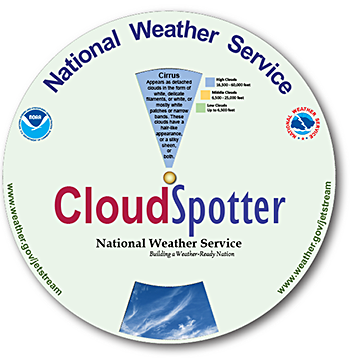Overview
Clouds are divided into four basic forms (cirro-form, strato-form, cumulo-form and nimbo-form) at three basic levels (low, middle and high) in the atmosphere. Many locations may experience all of these different types of clouds daily. The students will become better observers of the sky by recording the different cloud types at various times daily.
| TOTAL TIME | 5 minutes for each observation. |
|---|---|
| SUPPLIES | Scissors; Brass fasteners |
| PRINTED/AV MATERIAL | Access to the paper version of the NOAA Cloudwise Chart or the online version; Cloud observing form; CloudSpotter wheel |
| TEACHER PREPARATION |
If possible, plan this lesson within four days of an upcoming cold front. This will help maximize the variety of clouds the students will observe.
|
| SAFETY FOCUS | Foggy Weather Safety |
Procedure
- Have the students make their CloudSpotter wheel by cutting along all dotted lines.
- Fasten the two wheels together using a brass fastener.
- Show the students how to use the wheel, the NWS Cloud Chart or the online version of the Cloud Chart to determine the types of clouds they observe.
- Record cloud observation onto the Cloud Observation Form.
- Have the students repeat the cloud observation procedure again at home this evening and to make their observations as close to the same time as possible.
- Repeat for four days.
Discussion
Identifying clouds can be difficult at first. Have the students make their best effort in identifying the predominate cloud(s). Discuss any changes in the cloud type between the daytime observation at school and the evening observation at home.
Discuss how the types of clouds change during the week, especially if a front passes your location. Discuss how we can look at the clouds to help forecast the weather.
Building a Weather-Ready Nation
Fog is basically a cloud on the ground. It does not matter if you are at sea level or on top of a mountain - if there is a cloud at your local ground level, then it is called fog. Some places are known for their persistent foggy weather such as the Pacific Coast, Appalachian highland region, and New England.
The foggiest spot in the U.S. is Cape Disappointment, Washington, where it's foggy for an average of 2,556 hours per year (107 days). Avoid an accident by following these defensive driving tips when it's foggy:
- Avoid driving in heavy fog if possible. If you encounter foggy or misty conditions, find a safe place to park the vehicle, and wait until visibility improves before driving again.
- Maintain a safe stopping distance during reduced visibility by reducing speed so you can stop safely within the distance you can see.
- Use low-beam lights. In fog, high beams reflect back to the driver, actually reducing visibility further.
- If visibility is extremely poor, you must pull off the road and park in an area as far away from traffic as possible.



